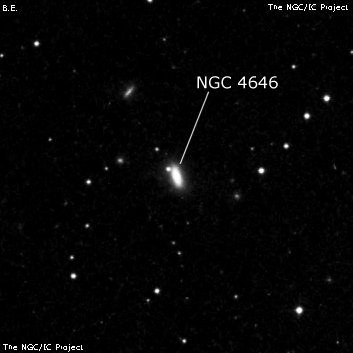
William Herschel discovered NGC 4646 = H II-910 = H II-794.2 = h1407 on 2 Apr 1791 (sweep 1001) and noted "F, S". His position (CH's reduction) is within 1' of UGC 7891. WH incorrectly assumed this object was II-794 = NGC 4644, located 16' north, and didn't assign a new internal number or include it separately in his catalogues. JH recorded "Has 4 vS stars south-preceding in a line." His position matches UGC 7891, though the string of stars is north-preceding.
JH sorted out the confusion with WH's two observations of II-794 in preparing the GC and listed them as II-794.1 and II-794.2. Dreyer concurs these are different objects in "Scientific Papers of William Herschel" and introduced the new number II-910 for the second observation.
Dreyer examined the field at Birr Castle on 25 Apr 1878. After observing NGC 4644, he moved 20' south and described NGC 4646 as "pB, E 50°, biN (Dist. 23"), 4 st nearly in a line p and a little n, 3'-4' from neb." The second "nucleus" is a very faint star at the northeast edge of the galaxy. Then he reported "A third nebula, biN in Pos. 16.5°, Dist 44", sp Nucl much the brighter, other one fainter and smaller, perhaps composed of st. This nebula is in Pos 71.5°, Dist 533" from [GC] 3179 [NGC 4646]." At this separation from NGC 4646 is the double galaxy UGC 7905, which fits Dreyer's description. He assumed this nebula was [GC] 5668 = NGC 4669, so UGC 7905 did not receive a NGC designation.
400/500mm - 18" (6/28/03): fairly faint, small, elongated 2:1 SSW-NNE, 0.5'x0.25', stellar nucleus. There appears to be a faint star at the NE tip (verified on DSS). A striking line of four mag 13-14 stars (total length 2.8') is close NW.
600/800mm - 24" (5/30/16): at 225x; moderately bright, fairly small, elongated 2:1 SSW-NNE, 0.6'x0.3', bright irregular core seems knotty. A mag 14.8 star is very close to the northeast edge. Four collinear mag 13-14.5 stars extending to the northwest begins 2.5' W.
UGC 7905, a disturbed, interacting system with tidal tails extending from both galaxies, lies 8.5' ENE. The pair is oriented SSW to NNE with centers separated by 35". At 225x, the southwest member (Mrk 220) appeared fairly faint, small, high surface brightness, roundish, 18" diameter. The northeast component (Mrk 221) appeared faint, fairly small, 18", low surface brightness. Only the central region was seen and I missed the tidal tail extending to the north and east.
Notes by Steve Gottlieb